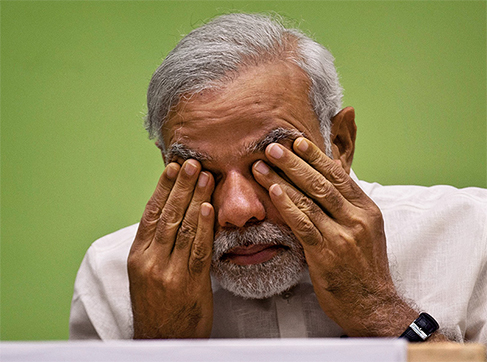
Shahmir Kazi
Narendra Modi’s BJP government is under tremendous pressure on many fronts as he is trying to prove himself a great reformer and in the process has stepped on too many toes.
He has however met his match in the protesting farming community that has besieged Delhi and its environs asking for withdrawal of regulations passed by the government.
Modi’s government has not been able to make them to agree to a compromise formula even after holding seven sessions of talks. For 41 days, the 41 farmers’ unions have been sitting on a protest at the Delhi borders demanding repeal of the three farm laws and they have shown no signs of relenting.
The farmer’s protest began on 26 November, with thousands of protesters gathering at highways leading to Delhi and the momentum has shifted a few times.
Initially, Modi tried to browbeat the farmers and it appeared that the farmers were prepared to accept a written guarantee on the Minimum Support Price (MSP) but the government lowered its guard and offered to amend the farm laws, the farmers’ unions appeared to harden their position.
The main reason however is that there is a deep lack of trust between the government and the farmers due to which the outcome of every round of negotiation has ended in failure. Quite obviously both sides have blamed each other for the impasse.
The government has been insisting that the three farm laws implemented through Ordinance route in June 2019 and passed by Parliament in September, are aimed at reforming agriculture and marketing of agriculture produces. The government has countered the protesters saying that the laws are not limited to the farmers of the granary of the country comprising of Punjab, Haryana and western Uttar Pradesh but also for farmers of other states.
To back its stand, the BJP leadership has referred to the past efforts in this connection and also allude to the 2019 manifesto of the opposition Congress Party that also had pledged undertaking such measures. The government and the BJP see the protest by farmers’ unions as an agitation by the critics of the Narendra Modi government hiding behind the farmers.
On the other hand, after the seventh round of talks, the farmers’ unions want nothing less than the repeal of the farm laws. They have mentioned that the government wants to discuss the laws with clause-wise but they only insist on repealing the laws.
They have categorically rejected any alternative method suggested by the government. The bitterness is increasing by the day as was evident by government ministers not sharing lunch with the representatives of the farmers’ unions, unlike the previous round of talks.
Keeping in view the situation, signs are now emerging that the government may be hardening its stand once again after showing willingness to concede grounds to the protesting farmers. There is a sense in the government that the protesters may have taken its willingness to amend the laws – as offered in the eight-page letter in December – as its weakness. Secondly, the understanding in the government is that the protest has sustained on account of behind-the-scene-support by opposition parties, particularly the Congress and the Left.
This comes from the fact that even though protesters have come from several states, the core of the thousands of protesting farmers is from Punjab, a state ruled by the Congress.
farmers modi
The leftist alliance ruing Kerala has extended its support to the farmers and the Aam Aadmi Party of Delhi Chief Minister Arvind Kejriwal too is helping farmers protesting at the Delhi borders.
This makes the BJP-led central government’s position unsuitable if it is seen to concede more than it can handle politically. This could be why the government has again hardened its position. It is back to “clause-wise” discussion of the farm laws to explain the merits of the legislation to the protesters.
After the farmers’ unions rejected a discussion on the merit of the laws, Union Agriculture Minister said that two hands are needed to clap and that both sides need to take steps forward to find a solution.
Meanwhile, pressure is building on the government to find ways to end the stalemate, given that the highway protest by thousands of farmers would soon gain international attention again as UK Prime Minister Boris Johnson is scheduled to visit India by the end of the month.
The farmers however are resilient and they have planned a tractor march that reveals that they are planning to intensify their protest after the government refused to repeal the laws.
The farmers intend to take out tractor march at four borders of Delhi including Eastern and Western peripheral and point out that this march will be the prelude to the massive protest they plan for Indian Republic Day on 26 January 2021.
A word or two about India’s farming sector may bring to fore its crucial position in the Indian socio-economic position. Indian agricultural sector is vast and troubled providing livelihood to nearly 70 per cent of the country’s 1.3 billion people and accounts for around 15 per cent of the $2.7 trillion economy. The forward-looking policies in 1970s turned India from a country facing regular food shortages into one with a surplus and a major exporter but for the past few decades, farm incomes have remained largely stagnant and the sector is in sore need of investment and modernisation.
More than 85 per cent of farmers have less than two hectares (five acres) of land and fewer than one in a hundred farmers own over 10 hectares. In addition, India hands out an estimated $32 billion
in subsidies to farmers annually. The salient issues facing the sector are water shortages, floods and increasingly erratic weather caused by climate change, as well as debt that have taken a heavy toll on farmers. Farmers and their workers are also abandoning agriculture in droves — 2,000 of them every day according to the last census in 2011.
Keeping in view the centrality of the matter, successive Indian governments have long made big promises to farmers and Modi is no exception, vowing to double their incomes by 2022.
In September, parliament passed three laws that enabled farmers to sell to any buyer they chose, rather than to commission agents at state-controlled markets. These markets were set up in the 1950s to stop the exploitation of farmers and pay a minimum support price (MSP) for certain produce.
The system has led to farmers sometimes growing crops unsuited to the local climate, such as thirsty rice in Punjab and can be fertile ground for corruption. But many farmers see the MSP as a vital safety net and fear being unable to compete with large farms and being paid low prices by big corporations. The famers openly express that land, cattle and farmers will be enslaved by rich people. In rural areas, where 70 per cent of Indians live, there is already a growing perception that Modi is cosy with big business and billionaire industrialists such as Mukesh Ambani, Asia’s richest person.
This is by far the biggest challenge to BJP government and it will have to find a way to walk back and save face at the same time. The Weekender


